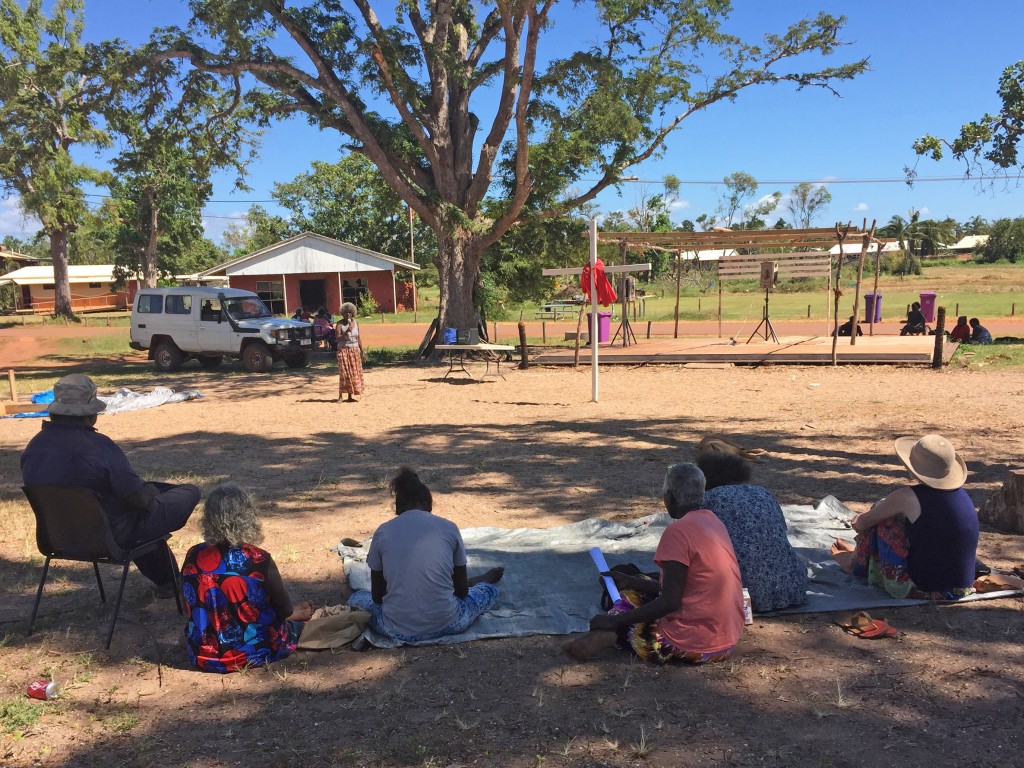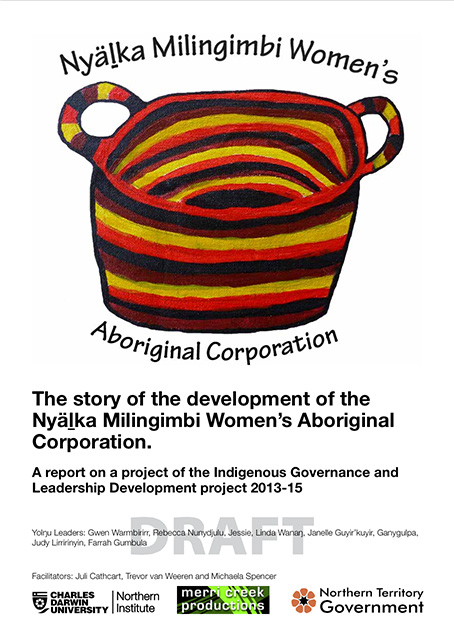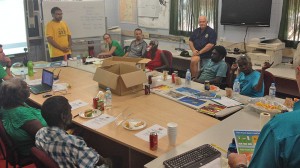In preparation for a promised visit from the Chief Minister (Adam Giles), in response to a community petition that raised a number of concerns in relation to Governance and Leadership, Law and Order, Education etc, Näkarrma Guyula started documenting how Governance worked from a Yolŋu perspective. Below are some of the headings with brief descriptions that outline many of the concepts and practices that underly the way people organise themselves and make decisions. This is an early draft. We are continuing to develop this resource.
Creation story (Djank’wu ga Barama) where our law comes from
In the beginning, Djaŋ’kawu ancestral creators landed on the eastern shores of Arnhem Land. They were Guŋgurrkuŋgurr (empowered with cosmic cultural knowledge, wisdom, constitution and governance).
Dry ground was struck with Ganinyiḏi, a Dhuwa spiritual wapitja (walking stick) wielded by the creator beings, and water came gushing out. The ground turned into a living sacred waterhole and was named Milminydjarrk. The water flowing out of the sacred waterhole was sacred and was named Milŋurr (wisdom and knowledge). The Djaŋ’kawu creators looked up and saw Wolma, a cumulonimbus cloud. It acknowledged their presence through Djirrikay (Thunder). The area on and in the ground, the waters, above and around was declared Djäpul Makarr Dhuni’, a sacred site, the site of the maḏayin law, the Parliament for Yolŋu.
Djaŋ’kawu passed on jurisdiction for the governance of knowledge systems from the sacred Milŋurr, to our forefathers, who passed it on to our fathers, and our fathers passed it on us. That process became the legal law which we live by today
The elders/leaders from the Djaŋ’kawu clan nations took the djota muḻuḻu (knowledge tree) out of the Djäpul sacred site. They planted it (Something like what Captain Phillip did when he, mistakenly, planted the Union Jack on Australian soil proclaiming it a colony of Great Britain in 1788) on the common ground where it became a Riyawarra (Makarr Garma) a place of legal public practice and participation and performance). Through the Riyawarra the laws and governance for all Yolŋu are made visible. This is where the laying down of the law was finalised. These laws and governance principles were given to Yolŋu by these unseen creators. This law remains unchanged.
We didn’t make up this law, in the creation time the land had no people, the Djang’kawu came and created the Yolŋu and gave them these laws to live by.
Yolŋuw Makarr Dhuni (Parliament) is the actual land of, water, space below and space above. It has no depth, height and size. Yolŋu Jurisdiction comes from the Milŋurr which holds destiny. It is unchanged by mortal knowledge.
Only those who spiritually seek that destiny of the Djaŋ’kawu see them submerging at sunset horizon as two worrutj (lorikeet) parrots to this day
We are a people with wisdom and knowledge. Our Milŋurr is alive and cosmic, it never runs out. We seek and gain that Milŋurr through practice and participation on the Makarr Garma.
The law is made manifest through the land by ceremony, song, dance, designs and painting, and objects. Our governance processes such as peacemaking, conflict resolution, discipline, the whole Yolŋu constitution is contained in these manifestations.
Our forefathers and our fathers carried on that Maḏayin system of governance ever since the beginning
We feel that our laws and practices have not been respected, valued or recognized. We seek a new engagement based on respect, and recognition. We need a seat at the table so we can be partners in our futures.
What follows are some descriptions of some of the laws and processes we practice. Through engaging equally with all stakeholders and decision makers we seek to have these laws recognized and a new Memorandum of Understanding (Treaty) and process agreed to. Something that lives beyond the cycles of elections and changes in policy.
Issuing from this Milŋurr described is our foundational governance system Gurruṯu
Gurruṯumirri rom
Ever since the ancestors first moved over the land and sea, every Yolngu has been born into a vast network of kinship called gurruṯu. Gurruṯu is the glue that holds our communities, clans, people and land together. Gurruṯu maps not only individuals into their extended families, but also whole groups of people into networks of clans, and corresponding totems, estates, languages, ancestral images etc. Underlying gurruṯu, is rom. Sometimes referred to as ‘law’, rom, includes many processes, structures, laws and customs.
Milmarra
Bon-Milmarra relates to your in-laws who are from the opposite moiety to you, this is where your wife or husband will come from, these relationships have various rules associated with them
Mirrirri rom
Mirrirri rom rules around brothers and sisters
Manggupuy
Manggupuy – (blood relation) caretaker uncle for a young initiates
These laws were practiced around our campfires, western culture and laws continue to threaten these systems. Balanda culture and laws are taking us away from these systems and destroying our culture. We are not saying we want to go back to the old ways but we are saying that both laws need to be negotiated together to find common ground.
We won’t be putting amendments into Yolŋu law, but we can find common ground. We have the processes for doing this through gumurrkunaminyawuy rom (see below). This requires trust, honesty and commitment from both sides, we have been asking for this for a long time…
Raypirri rom – Discipline law
We have been disciplining our children and community through both ceremonial and domestic practices and according to our law. We discipline our children at home, when they are mature boys and girls, and when boys are ready for circumcision at the Makarr Garma. We teach and discipline young men at the Makarr dhuni and we do it at Makarr Garma for both young older boys and older girls.
We give tough love discipline for young men and young women when they break yolŋu law
Dhapi rom
The circumsion ceremony
Ŋarra rom –
The next level of learning
Nuŋgat rom –
This law is a very strict one and relates to punishment for breaches of law within ceremonial contexts that are totally prohibited.
Makak rom – Law of respect
When entering and or, passing through someone else’s makarr garma must be respected at all times
Wetj
Sharing resources in equal shares. For example; when a group of yolŋu go hunting, they all go out catch and gather bush tucker. They come together at a fireplace and through wetj, the catch is distributed according to Gurruṯu and Makmak conventions.
Ḻay-gora –
Serving others first before your family, clan, or clan nation
Gumurrkunaminyawuy rom
This literally means chest to chest (open hearted and truthful towards each other) Through holding the principles of Gumurrkunaminyawuy at the centre of our negotiations we can enter into business agreements through Djugu rom (ŋärra rom, mamurrŋ, marradjirri, buku-wuṯ) This is where we can close the real gap.
Djugu rom
This is like a contract law. Through Djugu, arrangements can be made that hold each party to an agreement.
Police station is a balanda institution situated inside Yolŋu makarr garma. Together Yolŋu law and order, and balanda law and order can work together on the related issues
Magaya rom- Peacemaking
Peacemaking is something we are always working towards, certain people are recognized for their skills in this area. Peacemaking is an
Makarraṯa
Makarraṯa is a peace making ceremony. Although Makarraṯa is not practiced these days it still informs our conceptual understanding of justice.


 On the 9th April 2014, we presented a report on stage 1 and 2 of the Governance and Leadership project, to the Community Advisory Board of the East Arnhem Shire in Milingimbi. The report reiterated the goals of the project and reminded people about who was involved. It gave a brief outline of what we had done in stage 1 and sketched out the areas we planned to work on in stage 2. It included some pictures of meetings we had, and a detailed illustration of the sorts of activities we would be doing in stage 2. It was a busy meeting with Power and Water also presenting (see image) an employment project aimed at reducing water consumption, and enhancing reporting processes.
On the 9th April 2014, we presented a report on stage 1 and 2 of the Governance and Leadership project, to the Community Advisory Board of the East Arnhem Shire in Milingimbi. The report reiterated the goals of the project and reminded people about who was involved. It gave a brief outline of what we had done in stage 1 and sketched out the areas we planned to work on in stage 2. It included some pictures of meetings we had, and a detailed illustration of the sorts of activities we would be doing in stage 2. It was a busy meeting with Power and Water also presenting (see image) an employment project aimed at reducing water consumption, and enhancing reporting processes.